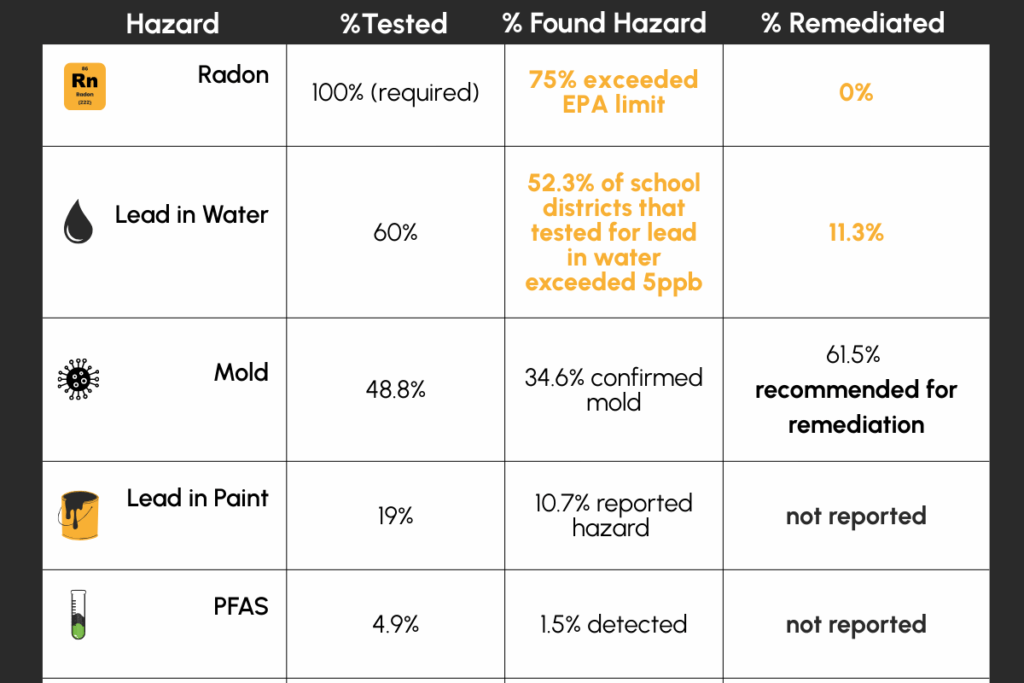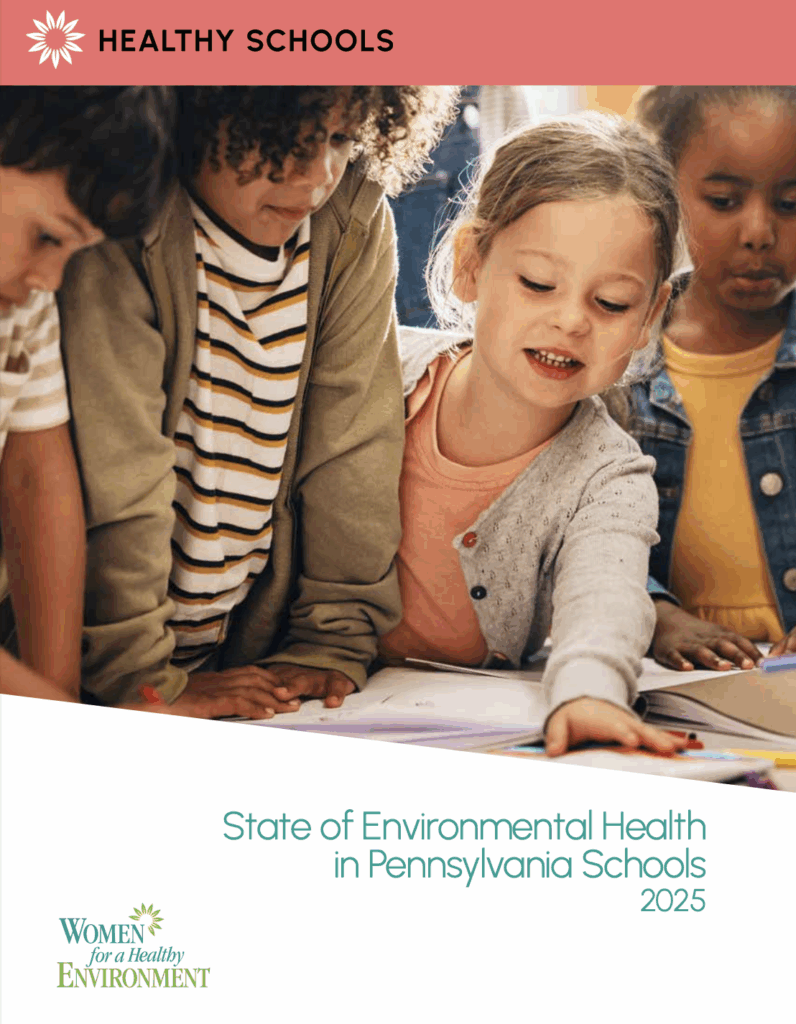Every child deserves a healthy learning environment
When children have a healthy and safe learning environment, children not only have a greater opportunity for healthy development and decreased absenteeism, but research shows there is a greater ability to achieve academic potential.
Our report reveals how environmental hazards in school buildings are putting students at risk—and how we can act.
WHE’s 2025 State of Environmental Health in PA Schools report exposes widespread lead exposure in water and paint, elevated levels of radon, frequent mold and moisture problems, poor air quality, and a troubling rise in synthetic turf fields. These conditions are especially acute in older buildings and disproportionately impact low-income and communities of color.
The data tells a clear story: environmental hazards are widespread in our schools—and action isn’t keeping pace. Without stronger requirements and funding, many schools will continue to leave health risks unaddressed.
75%
of schools that tested for radon, found exceedances above EPA action level
3.8%
of schools have an indoor air quality (IAQ) plan
11%
of schools that found lead actually fixed it
1978
most PA schools were built before this year
7.5%
of schools use certified green cleaning products
The 2025 State of Environmental Health in Pennsylvania Schools report reveals a consistent pattern: hazards are being identified, but rarely addressed. This snapshot summarizes what was tested, what was found, and what—if anything—was done about it across five key environmental health risks.

Older buildings, greater dangers: Pennsylvania has many schools built before the ban on lead paint (1978) and PCBs (1979). This increases exposure risks for contaminants still present in walls, pipes, caulk or light fixtures.



How Other States Are Taking the Lead
States like New York and Vermont have adopted stronger school health policies—from mandatory water testing to green cleaning laws. Pennsylvania still has work to do.

Take Action for Healthier Schools
Whether you’re a parent, teacher or school staff member you have the power to make a difference. The environmental hazards in our schools—like lead, radon, and poor indoor air quality—are preventable. Use the tools below to push for stronger policies, and help create healthier learning spaces for every student

Path To A Model District

Parent Power Kit
For Parents
Ask Questions. Start Conversations. Demand Better.
Ask Your School These 10 Questions.
Has our school been tested for radon in the past five years?
Can I see the results of the most recent lead in water testing?
Are we using 3rd party, green-certified cleaning supplies?
Are there anti-idling signs where students are dropped off and picked up?
Is there a full-time school nurse on staff?
Do the classrooms have working ventilation or air purifiers?
Does the school an IAQ management plan? Has the HVAC system been inspected and serviced in the last year?
Does the district have a dashboard or website where environmental testing results are shared?
Are parents notified before pesticides are used in or around the building?
Can I see the school’s Integrated Pest Management (IPM) plan?
January: “Has the district reviewed indoor air quality issues this winter? Are HVAC filters being changed on schedule?”
February: “Are any renovation or capital improvement projects being proposed in this year’s budget that relate to environmental health?”
March: “Has our HVAC system been serviced or inspected this school year?”
April: “When were our water fountains last tested for lead? Are the results available online?”
May: “Can we review the school’s Integrated Pest Management plan?”
June: “Are there any plans to test for mold, radon, or lead while school is out?”
July: “Will the school share a summary of environmental test results or facility upgrades before the new school year?”
August: “Does the school use green-certified cleaning products? Are custodians trained on safer alternatives?”
September: “Has our school posted anti-idling signage and are drop-off zones monitored for compliance?”
October: “Are parents informed when pesticide treatments are scheduled near playgrounds or classrooms?”
November: “What steps is the district taking to address asthma triggers and indoor allergens before winter?”
December: “Does our district track or report absenteeism due to asthma or air quality concerns?””Can we review the school’s Integrated Pest Management plan?”
Send to your principal, superintendent, or facilities manager.
- “This issue matters to me as a parent because my child deserves to learn in a healthy environment.”
- “Data shows mold, radon, and chemical exposures are still present in many schools — but solutions exist.”
“Other districts are taking action — we can too.” - “We’d like to see a public update on environmental testing and steps the district is taking.”
- “Schools are required to follow certain environmental health laws like Act 39 for lead and Act 35 for pest management. If they haven’t tested, they must publicly disclose it — and we deserve to know.”
For School Leaders
You don’t have to navigate these challenges alone. From model policies to grant programs, tools exist to help you improve indoor air quality and upgrade aging systems. Start here—and reach out if we can help.
Many environmental health upgrades can be supported through a combination of state, federal, and local funds. While not all opportunities are open at all times, WHE can help identify potential funding sources and assist with grant strategy or planning.
Examples of potential funding sources include:
Local capital budgets or construction allocations
This benchmark checklist defines the core practices of a model school district—spanning radon, lead, water, indoor air quality, facilities, and engagement. Use it to evaluate your district and guide planning.
For Legislators
Pennsylvania schools are facing widespread environmental health challenges—lead in water, unsafe radon levels, outdated HVAC systems—yet current policies fall short of protecting students. This section outlines the key policy gaps, legislative priorities, and tools for action.
Students are attending school in buildings where radon, lead, mold, and poor air circulation are common—but there’s no statewide mandate to fix these problems. Even when hazards are found, most schools are not required to act.
Key Gaps:
- Schools are not required to test for radon.
- PA’s regulations to test for lead-in-drinking water in schools is outdated. Schools are required to use a filter first approach.
- No requirement exists to disclose environmental test results publicly.
- Policies like anti-idling and integrated pest management are often not followed nor enforced.
- No permanent state funding exists to ensure all districts, especially under-resourced ones, can test and fix hazards.
WHE and partners recommend the following priorities for the next legislative session. These actions are cost-conscious, data-backed, and supported by national best practices.
Recommended Priorities:
Mandate radon testing and mitigation every 5 years, with public reporting
Mandate a filter-first approach for lead in schools drinking water.
Create a permanent state fund for testing and remediation (modeled after Act 33)
Require schools to publish environmental test results in a public, accessible format
Protect students on poor air quality days (require monitoring + indoor recess on AQ alert days)
These reforms are practical, bipartisan, and urgently needed to protect Pennsylvania’s 1.7 million public school students.
Lawmakers have the opportunity to fix the gaps in Pennsylvania’s school environmental health system. Use the tools below to take action.
Contact WHE for policy support.
At South Fayette, we take pride in being student-centered, future-focused, and innovation-driven and ensuring a healthy environment for our students, faculty, and staff.
The quality of the learning environment is foundational to student success and staff well-being, which is why we have updated equipment to maintain the air quality throughout our facilities and are following industry guidelines in our current renovation and construction projects. I encourage all school leaders to view environmental health not as an extra initiative, but as a critical investment in the future of every learner and educator in their care.
Dr. Michelle Miller, Superintendent South Fayette School District
